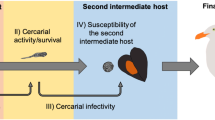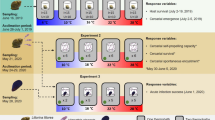Abstract
Alterations of abiotic factors due to global climate change are predicted to impact disease dynamics, particularly for pathogens with complex life cycles involving free-living infectious stages, such as the cercariae of trematode parasites. Previous investigations of cercarial output, longevity, and infectivity suggest an overall increase in trematode transmission in response to elevated temperature. However, while increased temperature will likely be accompanied by changes in salinity and pH in marine ecosystems, little is known regarding their influence on cercariae. We investigated the response of trematode cercariae of the intertidal horn snail Cerithidea californica to altered temperature, salinity, and pH. The survival and activity of one trematode species, Euhaplorchis californiensis (Heterophydae), appears to be largely unaffected by increased temperature, while that of a second species, Acanthoparyphium spinulosum (Echinostomatidae), decreased at the warmer temperature (25°C). Cercariae of E. californiensis generally fared best at the highest salinity (40 ppt), whereas A. spinulosum showed the opposite effect. Neither species was affected by pH alone although there were interactions with salinity and time. These results may reflect different emergence patterns of the two species and demonstrate that trematode parasitism in intertidal zones may be impacted by alterations of the marine environment resulting from climate change.


Similar content being viewed by others
References
Boyer TP, Antonov JI, Garcia HE, Johnson DR, Locarnini RA, Mishonov AV, Pitcher MT, Baranova OK, Smolyar IV (2006) World ocean database 2005. In: Levitus S (ed) NOAA Atlas NESDIS 60. US Government Printing Office, Washington
Caldeira K, Wickett ME (2003) Anthropogenic carbon and ocean pH. Nature 425:365
Combes C, Fournier A, Mone H, Theron A (1994) Behaviours in trematode cercariae that enhance parasite transmission: patterns and processes. Parasitology 109:S3–S13
Curry R, Mauritzen C (2005) Dilution of the northern North Atlantic Ocean in recent decades. Science 308:1772–1774
Day JW Jr, Hall CAS, Kemp WM, Janez-Arancibia A (1989) Estuarine ecology. John Wiley and Sons, New York
Evans NA (1985) The influence of environmental temperature upon transmission of the cercariae of Echinostoma liei (Digenea: Echinostomatidae). Parasitology 90:269–275
Fingerut JT, Zimmer CA, Zimmer RK (2003) Patterns and processes of larval emergence in an estuarine parasite system. Biol Bull 205:110–120
Gordon AL, Giulivi CF (2008) Sea surface salinity trends: over fifty years within the subtropical North Atlantic. Oceanography 21:21–29
Hakalahti T, Karvonen A, Valtonen ET (2006) Climate warming and disease risks in temperate regions—Argulus coregoni and Diplostomum spathaceum as case studies. J Helminthol 80:93–98
Harvell CD, Mitchell CE, Ward JR, Altizer S, Dobson AP, Ostfeld RS, Samuel MD (2002) Climate warming and disease risks for terrestrial and marine biota. Science 296:2158–2162
Karvonen A, Paukku S, Valtonen ET, Hudson PJ (2003) Transmission, infectivity and survival of Diplostomum spathaceum cercariae. Parasitology 127:217–224
Key RM, Kozyr A, Sabine CL, Lee K, Wanninkhof R, Bullister J, Feely RA, Millero F, Mordy C, Peng T-H (2004) A global ocean carbon climatology: results from GLODAP. Glob Biogeochem Cycles 18:GB4031
Knauss JA (1978) Introduction to physical oceanography. Prentice Hall, New Jersey
Koprivnikar J, Poulin R (2009) Effects of temperature, salinity, and water level on the emergence of marine cercariae. Parasitol Res 105:957–965
Koprivnikar J, Forbes MR, Baker RL (2006) Effects of atrazine on cercarial longevity, activity, and infectivity. J Parasitol 92:306–311
Kuris A (1990) Guild structure of larval trematodes in molluscan hosts: prevalences, dominance and significance of competition. In: Esch GW (ed) Parasite communities: patterns and processes. Chapman and Hall, London, pp 69–100
Lafferty KD (2008) Ecosystem consequences of fish parasites. J Fish Biol 73:2083–2093
Lafferty KD, Morris AK (1996) Altered behavior of parasitized killifish increases susceptibility to predation by bird final hosts. Ecology 77:1390–1397
Marcogliese DJ (2001) Implications of climate change for parasitism of animals in the aquatic environment. Can J Zool 79:1331–1352
Martin WE (1950) Euhaplorchis californiensis n.g., n. sp., Heterophyidae, Trematoda, with notes on its life cycle. Trans Am Microsc Soc 69:194–209
Martin WE (1972) Annotated key to the cercariae that develop in the snail Cerithidea californica. Bull So Calif Acad Sci 71:39–43
Martin WE, Adams JE (1961) Life cycle of Acanthoparyphium spinulosum Johnston, 1917 (Echinostomatidae: Trematoda). J Parasitol 47:777–782
McCarthy AM (1999) The influence of temperature on the survival and infectivity of the cercariae of Echinoparyphium recurvatum (Digenea: Echinostomatidae). Parasitology 118:383–388
Mouritsen KN (2002) The Hydrobia ulvae—Maritrema subdolum association: influence of temperature, salinity, light, water-pressure and secondary host exudates on cercarial emergence and longevity. J Helminthol 76:341–347
Mouritsen KN, Poulin R (2002) Parasitism, community structure and biodiversity in intertidal ecosystems. Parasitology 124:S101–S117
Mouritsen KN, Poulin R (2005) Parasites boost biodiversity and changes animal community structure by trait-mediated indirect effects. Oikos 108:344–350
Mouritsen KN, Tompkins DM, Poulin R (2005) Climate warming may cause a parasite-induced collapse in coastal amphipod populations. Oecologia 146:476–483
Orr JC, Fabry VJ, Aumont O, Bopp L, Doney SC, Feely RA, Gnanadesikan A, Gruber N, Ishida A, Joos F, Key RM, Linday K, Maier-Reimer E, Matear R, Monfray P, Mouchet A, Najjar RG, Plattner G-K, Rodgers KB, Sabine CL, Sarmiento JL, Schlitzer R, Slater RD, Totterdell IJ, Weirig M-F, Yamanaka Y, Yool A (2005) Anthropogenic ocean acidification over the twenty-first century and its impact on calcifying organisms. Nature 437:681–686
Pechenik J, Fried B (1995) Effect of temperature on survival and infectivity of Echinostoma trivolvis cercariae: a test of the energy limitation hypothesis. Parasitology 11:373–378
Pietrock M, Marcogliese DJ (2003) Free-living endohelminth stages: at the mercy of environmental conditions. Trends Parasitol 19:293–299
Poulin R (2006) Global warming and temperature-mediated increases in cercarial emergence in trematode parasites. Parasitology 132:143–151
Poulin R, Mouritsen KN (2006) Climate change, parasitism and the structure of intertidal ecosystems. J Helminthol 80:183–191
Prokofiev VV (1999) Influence of temperature and salinity on a life span of cercariae of marine littoral trematodes Cryptocotyle sp. (Heterophyidae), Levinseniella brachysoma and Maritrema subdolum (Microphallidae). Parazitolgiia 33:520–525, in Russian
Shostak AW (1993) Survival of Petasiger nitidus (Digenea: Echinostomatidae) cercariae in relation to temperature, pH, and salinity. Can J Zool 71:431–434
Shostak AW, Esch GW (1990) Temperature effects on survival and excystment of cercariae of Halipegus occidualis (Trematoda). Int J Parasitol 20:95–99
Sindermann CJ (1960) Ecological studies of marine dermatitis-producing schistosome larvae in northern New England. Ecology 41:678–684
Sindermann CJ, Farrin AE (1962) Ecological studies of Cryptocotyle lingua (Trematoda: Heterophyidae) whose larvae cause ‘pigment spots’ of marine fish. Ecology 43:69–75
Sousa WP (1983) Host life history and the effect of parasitic castration on growth: a field study of Cerithidea californica Haldeman (Gastropoda: Prosobranchia) and its trematode parasites. J Exp Mar Biol Ecol 13:273–296
Sousa WP (1991) Can models of soft-sediment community structure be complete without parasites? Am Zool 31:821–830
Sousa WP, Gleason M (1989) Does parasitic infection compromise host survival under extreme environmental conditions? The case for Cerithidea californica (Gastropoda: Prosobranchia). Oecologia 80:456–464
Stunkard HW, Shaw CR (1931) The effect of dilution of sea water on the activity and longevity of certain marine cercariae, with descriptions of two new species. Biol Bull 61:242–271
Thieltges DW, Rick J (2006) Effect of temperature on emergence, survival and infectivity of cercariae of the marine trematode Renicola roscovita (Digenea: Renicolidae). Dis Aquat Org 73:63–68
Thieltges DW, de Montaudouin X, Fredensborg B, Jensen KT, Koprivnikar J, Poulin R (2008) Production of marine trematode cercariae: a potentially overlooked path of energy flow in benthic systems. Mar Ecol Prog Ser 372:147–115
Acknowledgements
We thank E. Payne for assistance in collecting snails as well as F. Shaheen, T. Le, and M. Tien for helping to carry out this study. All experiments performed comply with the current laws of the United States of America.
Author information
Authors and Affiliations
Corresponding author
Rights and permissions
About this article
Cite this article
Koprivnikar, J., Lim, D., Fu, C. et al. Effects of temperature, salinity, and pH on the survival and activity of marine cercariae. Parasitol Res 106, 1167–1177 (2010). https://doi.org/10.1007/s00436-010-1779-0
Received:
Accepted:
Published:
Issue Date:
DOI: https://doi.org/10.1007/s00436-010-1779-0




